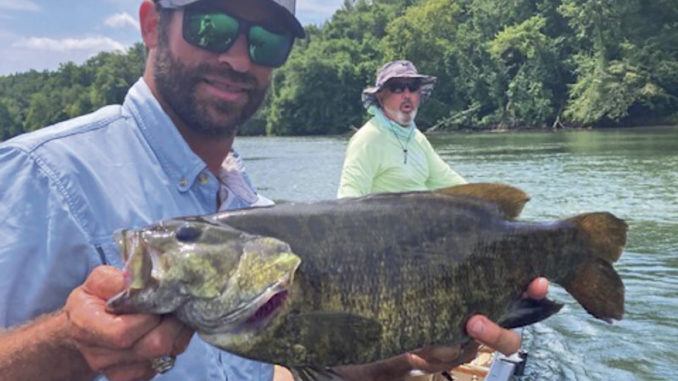
Hit the Broad River for hot smallmouth action
The heat baked overhead as Broad River Smallmouth fishing guide Mike McSwain balanced on one foot before stepping into his customized river fishing canoe. Once the craft was safely launched from one of the many private access points found on the Broad, McSwain began freely giving out advice on how to approach the fishing adventure that lay ahead.
“River fishing is so much different than what a lot of folks believe about fishing in lakes and ponds,” he said. “The conditions, the fish, the water, the scenery – it’s an entirely different world out here.”
River Structure
For anglers who are accustomed to fishing in impounded reservoirs, it’s second nature for the eyes to roam the bank looking for fish-holding areas. The bank of almost any river is lined with rock outcroppings, downed trees, undercut banks, and tons of eye-catching structure. According to McSwain, a few fish can be caught from these areas. But the lion’s share of fish in a river system don’t hold along the bank.
“Rivers are about current. Current brings food, current oxygenates the water, and current dictates the water temperature,” he said. “The best structure for holding fish is the rocks out in the river current. Most of these you can’t see because they’re underwater.”
He said anglers with a little experience under their belt can detect the location of the rock structure by learning to read the water. Smallmouth in the Broad River will hold on this structure year-round. But in the hot weather of summer, fish tend to hold around the faster water near rapids.
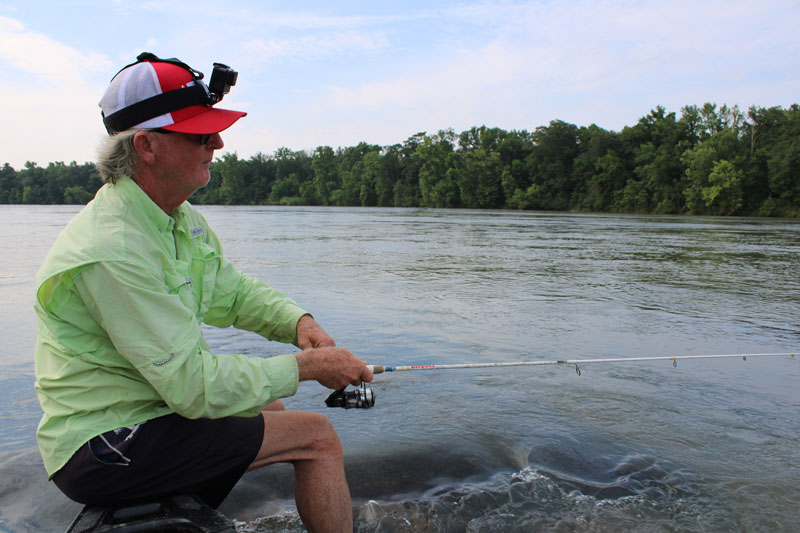
Boat Positioning
When guiding his clients on a smallmouth fishing trip down the Broad, McSwain takes care, and great pains, to position the boat where the client will be able to reach more than one good target area.
“You can see everything you need to see by looking back upriver,” he said. It’s important to get the boat positioned just right.”
McSwain said much of boat positioning depends on the direction of travel. If he’s spot fishing, he uses an electric trolling motor to propel the boat upriver. He instructs his clients to cast at upriver targets. If it’s a float trip, where he’s putting in at one spot and taking out at another downstream, he targets areas differently.
“Fish, especially smallmouth bass, will face upstream. That means when we come up on a shoal area, we’ll fish the top of the shoal first, both sides, then go through the rapid, turn around and fish the bottom of the shoals.”
Understanding current breaks is all-important in knowing where to cast. Each rock, or each shoal, will have two current breaks, one on each side that forms a V at the rock. Fish are likely to hide just inside the break and dart out into the current to strike. A third target is the eddy – the slack water behind the obstruction.
McSwain said there is little danger of spooking fish just by boating through the flowing part of the shoal. The big issue is banging the paddle or other items on the boat in the area and causing sonic vibrations.
“I don’t believe splashing or objects moving in the river impacts fish much,” he said. “They see it all the time. But banging noises, I see a lot of kayakers do this, banging their paddle on the boat while paddling, that tends to spook fish.”
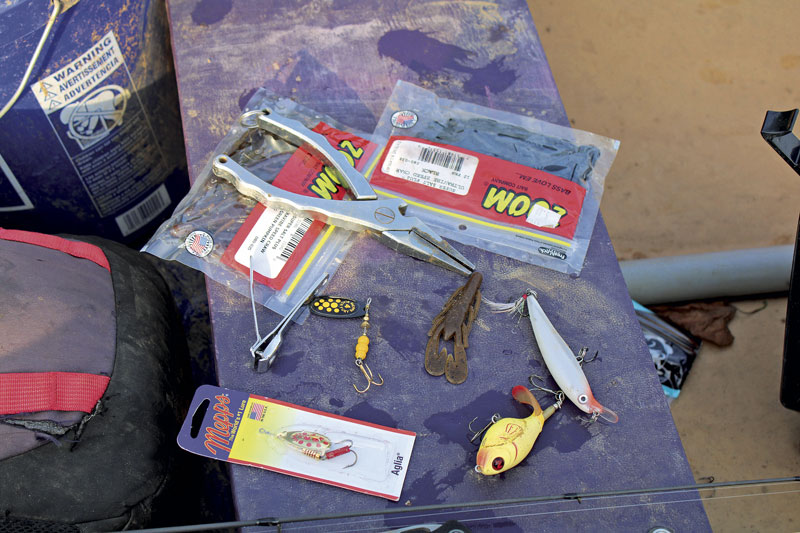
Lures
Regardless of whether an angler is fishing the Broad River for smallmouth, or any other flowing river that is home to trout, bass, stripers, and more, McSwain said it’s important for river anglers to have the right lures to target the entire water column.
Most flowing rivers with rapids tend to be on the shallow side with a maximum depth of 10 to 12 feet, and maybe 20 feet in a deep hole. McSwain usually has at least three rods pre-rigged. One with a topwater bait to target fish that are holding on or near the surface. Another rod will have a bait capable of targeting midwater depths. Some of his favorites are inline spinnerbaits, unweighted flukes or Senkos, and a square bill crankbait that dives to 6 or 7 feet. The third rod will hold a weighted plastic. This is a Texas rigged craw or other creature type bait that he can work along the bottom.
“Of all of these baits, the weighted plastic bait is the most important,” he said. “On great days, fish will feed throughout the water column. On good days, we catch them from the mid depths on down. But on the tough days, you have to be able to fish that crawfish imitating bait on the bottom. That’s where the fish hold the majority of the time.
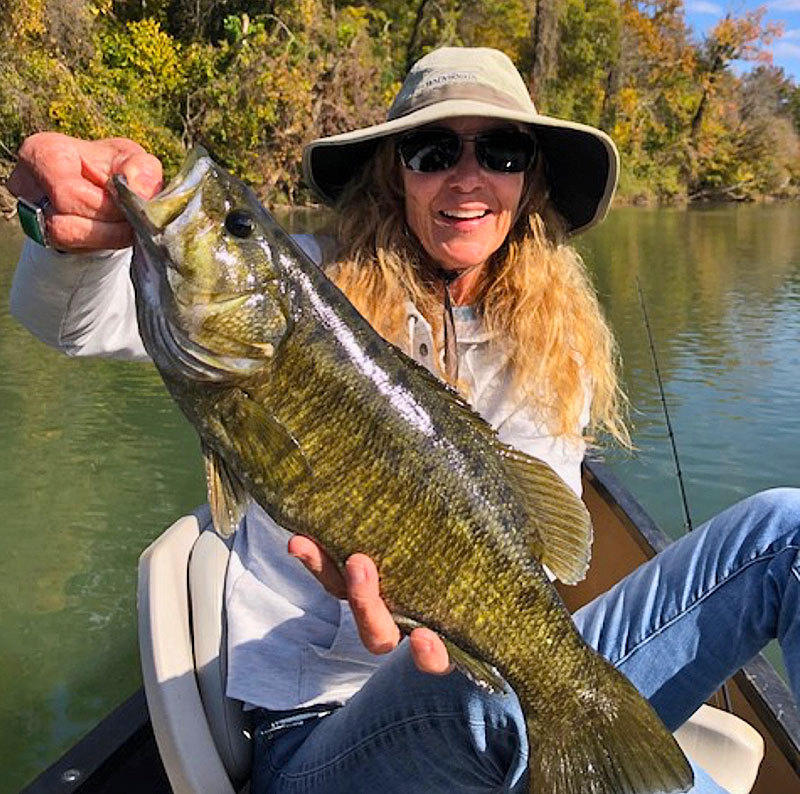
River Levels
Generally speaking, lake levels may change seasonally, with winter drawdowns and spring rises. On occasion the levels may rise or fall a few inches depending on rainfall. It generally goes unnoticed by the angler.
But for river fishing, anglers must pay close attention to water levels and the water flows that go along with them. McSwain said he won’t fish the river if it’s too high. The primary reason is safety. Fast water flows make for treacherous boating. In addition, the fishing is poor when fish are hunkered down and the water is muddy, which is usually the case when the river is flooding.
Low water, drought conditions are his favorite. Under these conditions, the river is super low, the water is gin clear, and much of the fishing area has been reduced.
“It’s like fishing in a barrel,” he said. “In super low water, fish pull back to the river channel, which is easy to see and cast to. River fish, smallmouth especially, are sight feeders and they can see the bait very easily in clear water. When the water gets low, my phone starts ringing off the hook.”
Conditions in between can vary greatly. Rivers that are tied to reservoirs, either for pump back operations or upstream hydroelectric generation may fluctuate daily or even hourly. McSwain relies on river gauges and river stage apps to determine the conditions before making a wasted trip. But overall, time on the water is his biggest indicator. Both dictate whether he’s going to fish, and where the fish are most likely to be when he goes.
To contact McSwain, call him at (843) 763-3805 or view his Facebook page – Broad River Smallmouth.
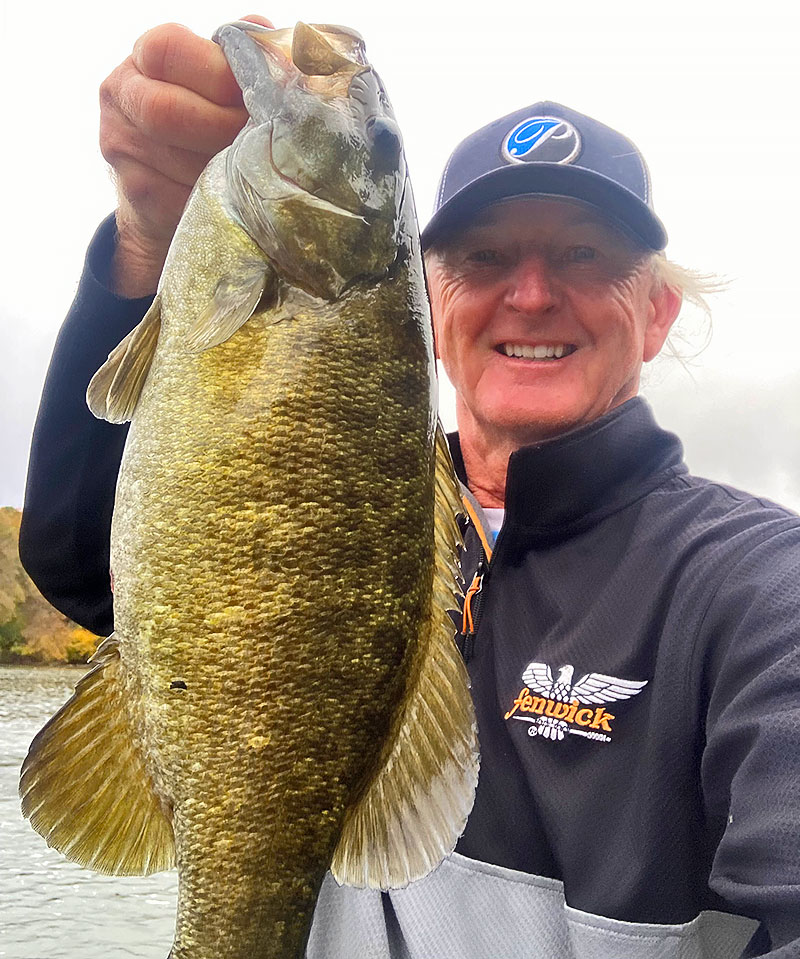
Big or small
According to smallmouth fishing guide Mike McSwain, anglers in the Carolinas who are more familiar with largemouth bass fishing may have some misconceptions about smallmouth fishing, and even the fish themselves.
His experience with smallmouth bass, which comes from the years he’s spent fishing the Broad River in South Carolina, is that smallmouth are more sight hunters than largemouth, which use their lateral lines to sense vibrations when hunting.
“This is why I like clear water and natural colors when I’m fishing for smallmouth,” he said.
As for bait size, he said the name small – mouth doesn’t mean these fish won’t hit standard sized crankbaits, spinnerbaits and soft plastics. Both species have big enough mouths to accommodate standard bass baits.
One big difference that he notices, even with the largemouth and smallmouth bass that reside in the Broad River, is that when the weather gets hotter, the smallmouths’ metabolism gets higher. Unlike largemouth, which tend to get sluggish in hot water, the highly oxygenated water jacks up the metabolism of smallmouth bass and makes them even more aggressive.
“I tell my folks to speed up the retrieve in hot weather,” said McSwain. “Rip that bait and get that fish excited and he’s gonna come after it.”
Additionally, McSwain said smallmouth tend to remain active longer through the colder months. He’s had good action while smallmouth bass fishing in water that’s in the upper 30-degree range.
McSwain said that other than that, it’s just bass fishing. Fish hold in ambush areas and they attack prey in pretty much all the same ways.
“If you can catch largemouth bass, you can catch smallmouth,” he said.


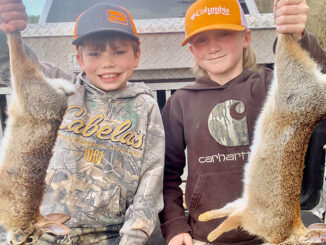
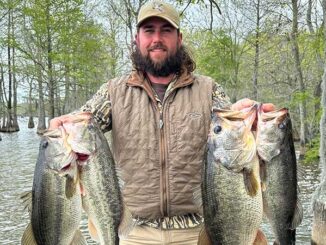

Be the first to comment